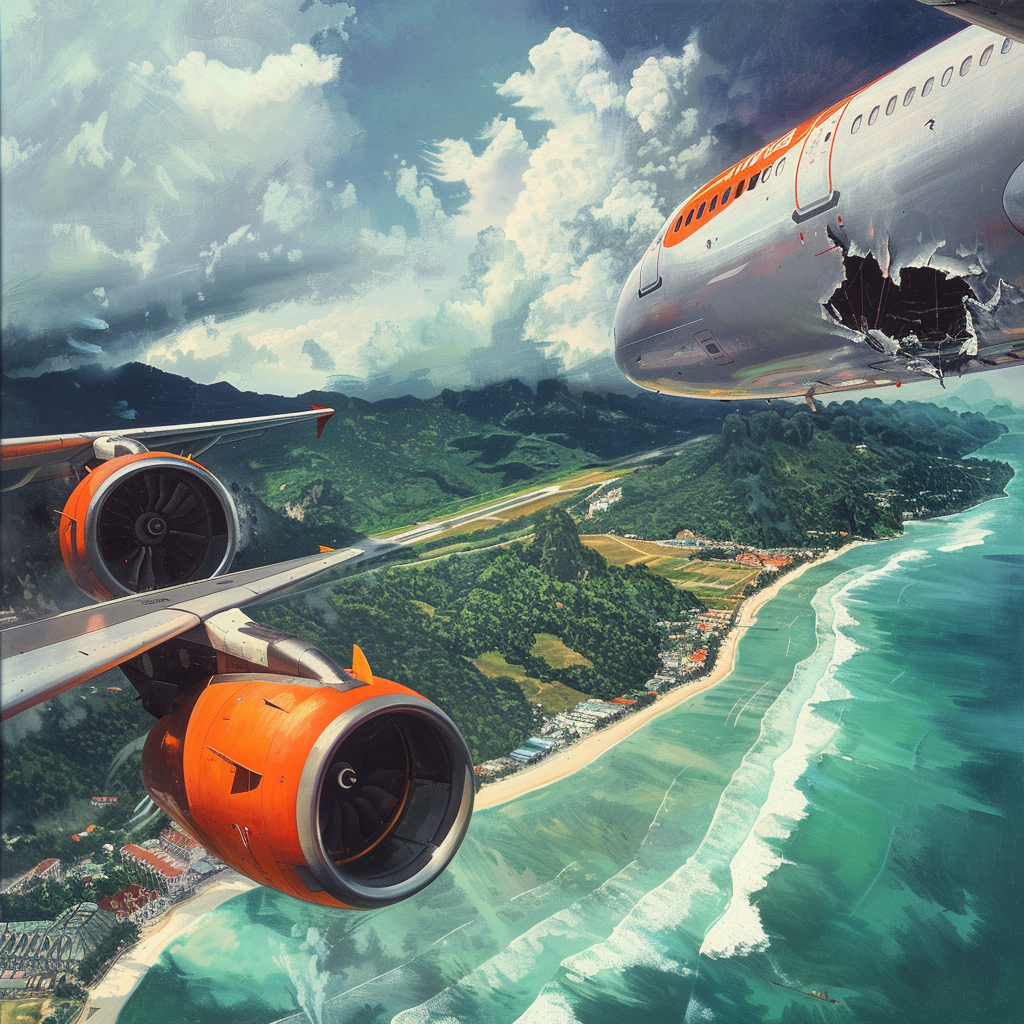Imagine the adrenaline rush of a roller coaster ride, your heart pounding against your chest, palms clammy with anticipation. Now picture experiencing that thrill thousands of feet in the air, with the added stakes of life and livelihood hanging in the balance. Such was the scene on a fateful Thai airline flight that veered into a realm of near disaster, leaving its passengers colored with tales of a harrowing journey and a newfound appreciation for the calm under pressure.
It was an ordinary day above the azure embrace of the Thai skies, or so it seemed, as the aircraft carved its path towards the scenic splendor of Phuket. But destiny had a different course in mind when, like an unexpected plot twist, one of the plane’s faithful engines decided to bow out of service. With the malfunction came an urgency that rippled through the fuselage, transforming the metal bird’s routine descent into a race against time.
Amidst palpable tension and pounding hearts, the flight crew emerged as the unsung heroes of this airborne drama. With steady hands and exemplary professionalism, they orchestrated a nerve-steadying performance that steered the vessel towards a safe haven at Phuket International Airport. Passengers, including 150 souls whose fate teetered on the brink, alighted unscathed—a testament to human resilience and the pilots’ unwavering resolve.
The Thai Civil Aviation Authority promptly stepped into the fray, confirming the gravity of the incident while lauding the crew’s decisive action. “The crew acted swiftly and ensured the safety of all on board,” a representative declared, encapsulating what many passengers could only murmur in gratitude amidst trembling breaths. One of the passengers, having just emerged from the ordeal, reflected, “It was scary, but I trusted the pilots,” echoing a sentiment that wavered between fear and faith.
As questions linger over the engine’s errant conduct, an investigation has taken flight, delving into the mechanics that nearly made an otherwise tranquil voyage one for the annals of aviation mishaps. In a proactive bid to assuage traveler nerves and maintain their exemplary safety reputation, the airline has pledged unwavering cooperation, underscoring their commitment to full transparency. For now, speculation merely whispers of what went astray when all seemed routine before takeoff.
Yet, the incident unfolds like a reminder penned by fate itself—cautionary tales abound in the skies we traverse. As experts weigh in, these rare engine malfunctions underscore the impermanence of certainty, the risks inherent in air travel often slumbering beneath the surface of our commuter consciousness. Amidst a chorus of calls for transparency, one common note emerges: the necessity for crystal-clear communication between airlines and passengers transcends mere comfort, it is the balm for anxiety in moments of crisis.
With the world’s eyes glued to this developing story, the airline reaffirms its promise to safety, casting a spotlight on reviewing protocols with the careful scrutiny of a masterful detective unraveling a mystery. The mission? To ensure confidence within the hearts of their passengers remains aloft, in tandem with their aircraft. As investigations continue, their aim is the same—to unearth the root cause of the engine’s capricious conduct and seal the breach before it can threaten tranquility again.
In a parallel story that unfolded like an episode of a surreal thriller, a returnee from Taiwan aboard a Thai Airways flight was gripped by hallucinations, his attempt to usher in an impromptu exit through the emergency door curtailed by vigilant flight attendants. This chilling episode only reinforces the necessity for preparedness in the face of the unpredictable, where the skies above Thailand serve as both a conduit for discovery and a crucible for mettle.


















As a frequent flyer, engine failures terrify me. The pilots’ calmness saved lives here.
Pilots train extensively for these scenarios. Most planes can fly on one engine, so relax!
True, but this trust in technology has led to complacency among airlines.
But not all flights end this well. Remember Sully on the Hudson?
This is just fearmongering by the media. Engine failures are rare and mostly non-fatal.
Rare, yes. But wouldn’t you prefer they happen zero times?
Articles like these highlight what could happen, compelling airlines to maintain high safety standards.
I can’t believe we trust our lives with machines that can fail at 30,000 feet.
Technological redundancy and human skill balance it out. We aren’t back in the Wright brothers’ times.
Except when tech and human skill collide. Pilots are fallible too, remember the 737 Max disaster?
This incident reminds me of past accidents. Airlines must learn from history to prevent repeats.
Past incidents lead to today’s safety protocols. Each ‘accident’ has lessons.
Isn’t the real issue how airlines downplay incidents? Silence breeds mistrust.
Transparency is key, but so is avoiding unnecessary panic. Tough balance.
True, but transparency should never take a backseat. Trust is earned.
Environmental impact of emergency landings! These failures might highlight inefficiency in our aviation tech.
Efficiency is important, but safety more so. Let’s keep planes in the air first!
Next time, they might not be so lucky. Continuous evaluations are needed.
Yes, but constant scrutiny isn’t sustainable. Trust aviation experts.
Pilots are trained for multiple catastrophic scenarios. Kudos to this crew for handling it well.
I can’t believe a hallucinating passenger nearly opened the emergency door. Airlines need better mental health protocol.
Let’s not forget that media dramatizes these stories. Engine failures are mostly managed with protocol.
This is why people still fear flying! Skills mean nothing when machines fail.
Transparency or not, more people need to fly to reduce the carbon footprint. Ground transport isn’t viable globally.
Air travel’s carbon footprint is significant! We should embrace alternatives.
Why do engine failures happen? Routine simulation doesn’t instill enough fear in pilots.
I used to love flying. These incidents make it seem like rolling the dice.
Drama sells news. Airlines operate millions of flights without trouble yearly. Fear not!
We should be thankful incidents like these don’t often escalate into complete disasters.
I commend the crew, but airlines must innovate to prevent engine failures altogether.
A mechanical failure shouldn’t be that serious if protocols are already in place.
It’s more about how airlines handle the aftermath and communication with passengers.
Investigations will reveal more insights. Public should wait for real conclusions.